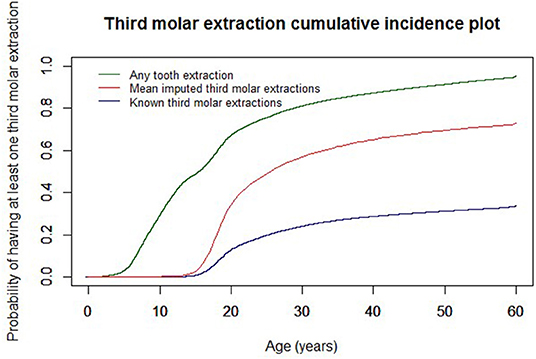An interesting article titled “Estimated Cumulative Incidence of Wisdom Tooth Extractions in Privately Insured US Patients,” written by Alan R. Schroeder and et. al. appears in Frontiers in Dental Medicine (July 2022, vol. 3, article 937165). The article sought to determine the cumulative incidence and predictors of wisdom teeth extractions in the US.
The article was motived by some of the controversy around wisdom teeth extractions and to better provide frequency estimates of the procedure to help inform future quality improvement initiatives and/or clinical trials. The authors used a national dental insurance claims database of privately insured patients (IBM MarketScan Dental Database), to help estimate the incidence of wisdom teeth extractions in the US and to determine variation by sex and geographic region. The authors included all patients in the database for their study who were under 60 years of age and enrolled in the insurance between January 1, 2007 and December 31, 2016 that had a wisdom tooth extraction identified. The authors attempted to identify wisdom tooth extractions by using CDT codes related to extraction, impacted, removal, and coronectomy, and tooth numbers 1, 16, 17, and 32 attached to the codes but the database had inconsistent tooth numbers. As a result the researchers used several approaches: (1) any tooth extraction regardless of tooth number; (2) documented wisdom tooth extraction accoridng to the tooth number; and (3) an aggregate of known wisdom tooth extractions plus imputed missing data on tooth number. The authors performed the imputing missing data on tooth numbers by using Classification and Regression Tree from the Multivariate Imputation by Chain Equation in the software package R. Additional details of the statistical analysis performed can be found in the original article.
The authors identified 26,482,180 million patients in the dental claims dataset during the study period and found that there were 9,945,392 extractions in 3,530,405 patients. The authors found that 1,280,923 (12.9%) extractions were specifically for wisdom teeth, 1,801,264 (18.1%) extractions were for teeth other than wisdom teeth , and 6,863,205 (69%) were for extractions that did not identify the specific tooth and thus had a missing tooth number. The authors found that 80% of the patients in their study had a tooth extracted. The authors estimated that approximately 50% or approximately 13.2 million patients of the 26,482,180 million patients had at least one wisdom tooth extracted by the age of 25. It was found that female patients were more likely to have wisdom teeth extracted. Those living in the Wes or South geographic regions of the US were more like to have a wisdom tooth extracted than those living in the Northeast egion of the US. The authors state:
“…we estimate that about half of adults undergo at least one [wisdom tooth] extraction by the age of 25 years and about 70% by age 60. [Wisdom tooth] extractions are performed slightly more commonly in females…. the procedure [is] performed more commonly in the West and South compared with the Northeast…”
While discussing their results the authors mention how their study results were similar to a study in the Pacific Northwest from 2009 to 10 which said removal of wisdom teeth for preventative reasons was recommended for 59% of 16–22 year-old patients and resulted in around 39% of patients having wisdom teeth removed to help prevent future problems. Controversy around wisdom teeth extraction remains. A recent Cochrane Review demosntrated there is insufficient evidence to determine whether asymptomatic wisdom teeth should be removed or retained. The American Public Health Association recommends against routine removal of wisdom teeth while the American Association of Oral and Maxillofacial Surgeons advocates for surgical extraction of diseased wisdom teeth and wisdom teeth at high risk of developing disease. The authors mention that their finding of geographic variations of wisdom teeth extractions may suggest that overtreatment is occuring and recommend future studies to explore the roots of the geographic differences.

The authors consider their results to be a necessary first step to better understand the overall risk benefit profile of this wisdom tooth surgery from a public health perspective. They mention that wisdom teeth surgery can cause harm due to exposure to opioids and carries surgical risks and risks from the anesthesia given. The authors mention the main limitation of their study is the high proportion of missing tooth numbers for the extraction claims in the dataset they used.
